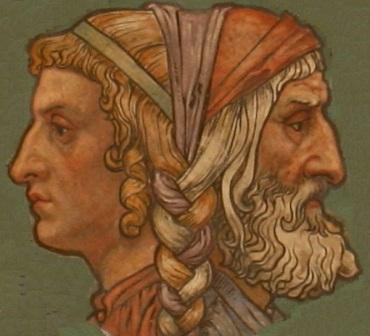The Roman god Janus (pictured above) is "the god of beginnings and transitions, and thereby of gates, doors, doorways, passages and endings."* Whether or not the month of January was actually named for him is less important than the suggestion that, at any major moment, there were precursors to the moment, and consequences following it. And, so, it is not surprising that, as one year winds down and another begins that pundits and commentators in a variety of disciplines look back at the year past. We've seen lists of the most important news stories, the most popular films, the best cute cat videos, etc., of 2014. A couple of the religious news podcasts I favor always address the most significant religious news stories or news-makers of the year; one seeks to identify the most under-reported stories. And they look ahead to see what MIGHT be important in the year to come. What I often find missing in ALL of these year-end stories--regardless of source--is some analysis of what we have learned from the reported-on events.
I started thinking about this when, this past week, I finally watched the movie "The Monuments Men" -- about a team of art historian/soldiers who were tasked with the job of recovering as much as possible of the art stolen by the Nazis in their marches through Europe. A scene early in the movie shows a discussion between some senior officers debating whether or not it is worth the cost and risk of sending men to find "art". The suggestion was that such art was old, and/or irrelevant. Fortunately, wiser heads prevailed and Bill Murray, John Goodman, George Clooney, Matt Damon, Hugh Bonneville and Cate Blanchett were sent on their way! The "wiser heads" made it clear that there were lessons in the art -- there were lessons in the past -- that made it definitely worth preserving.
Even more food for thought came from an article about a school in Oakland, CA, where a special education teacher started reclaiming "waste" land on the school property as a teaching tool for her students. They pulled weeds, recognizing that they were uninvited guests -- the whole process eventually revitalizing the whole school (and neighborhood). What struck me in the story was her statement: "When you remove something negative in your life, you need to replace it with something positive. I have some perennials and fruit trees we could put here." The perennials and fruit trees were put in, as well as playground educational art!
Art -- even what might be called "bad" art -- represents some part of human experience and longing that is worth saving and pondering. Personally, for example, I don't "get" Rothko, but I can't stop thinking about those huge panels of color. Or, when we look back at the year(s) past, what are the "weeds", the uninvited guests that we are better off removing or forgetting? But, equally important, with what do we replace them? I believe that every experience, every encounter, is an opportunity for bringing forth new life. Observing is one thing; recognizing a teaching is another. One simply looks back; the other looks both ways.
May our new year be full of wonder and learning!
Blessings,
I started thinking about this when, this past week, I finally watched the movie "The Monuments Men" -- about a team of art historian/soldiers who were tasked with the job of recovering as much as possible of the art stolen by the Nazis in their marches through Europe. A scene early in the movie shows a discussion between some senior officers debating whether or not it is worth the cost and risk of sending men to find "art". The suggestion was that such art was old, and/or irrelevant. Fortunately, wiser heads prevailed and Bill Murray, John Goodman, George Clooney, Matt Damon, Hugh Bonneville and Cate Blanchett were sent on their way! The "wiser heads" made it clear that there were lessons in the art -- there were lessons in the past -- that made it definitely worth preserving.
Even more food for thought came from an article about a school in Oakland, CA, where a special education teacher started reclaiming "waste" land on the school property as a teaching tool for her students. They pulled weeds, recognizing that they were uninvited guests -- the whole process eventually revitalizing the whole school (and neighborhood). What struck me in the story was her statement: "When you remove something negative in your life, you need to replace it with something positive. I have some perennials and fruit trees we could put here." The perennials and fruit trees were put in, as well as playground educational art!
Art -- even what might be called "bad" art -- represents some part of human experience and longing that is worth saving and pondering. Personally, for example, I don't "get" Rothko, but I can't stop thinking about those huge panels of color. Or, when we look back at the year(s) past, what are the "weeds", the uninvited guests that we are better off removing or forgetting? But, equally important, with what do we replace them? I believe that every experience, every encounter, is an opportunity for bringing forth new life. Observing is one thing; recognizing a teaching is another. One simply looks back; the other looks both ways.
May our new year be full of wonder and learning!
Blessings,
Gary
* http://en.wikipedia.org/wiki/Janus 'Tis kind of fun to see all the various rites and rituals connected with Janus!


No comments:
Post a Comment